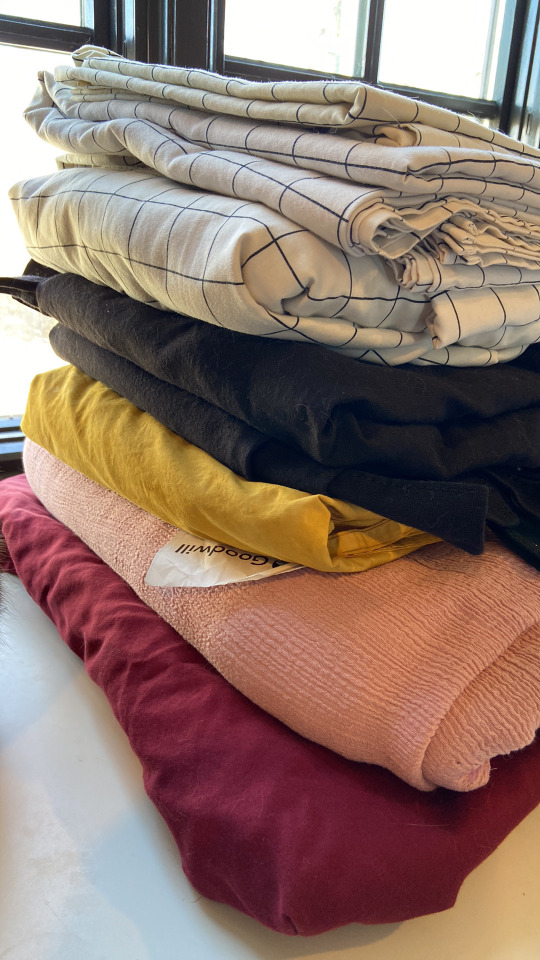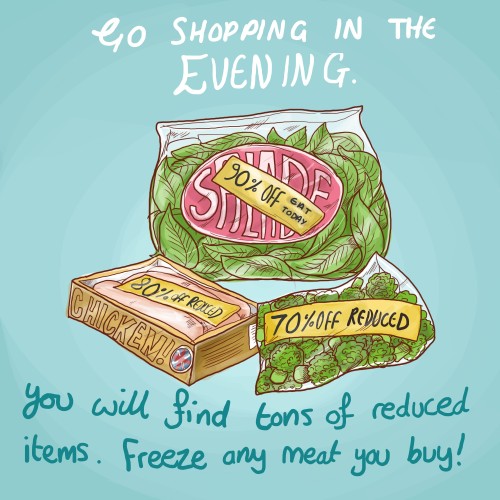Budget - Blog Posts
I recently saw a post lamenting how expensive sewing as a hobby is, which has been nagging me all day and of course now I can’t find it anymore.
It is, in fact, quite an extensive hobby and you can get bogged down by the capitalism monster thinking you need to buy a ton of things right away. You don’t! I’ve been sewing most of my life and have been slowly collecting tools and things as I need them but you can start off real small! Here are some random tips from me to you:
Sewing patterns: there are butt loads of free patterns all over the internet. Check out Mood patterns, Peppermint magazine, and your local library for the pattern bind up books if you’re lucky. However, indie patterns are totally worth the price, especially for beginners. They tend to have great instructions and better fit than the paper patterns you can find in stores and they come from people with a real passion for sewing. If you’re going more historical costuming, some of the free patterns can be finagled, but your best bet (besides drafting) is to purchase patterns depending on your era, just avoid Sense and Sensibility patterns. You can also find vintage patterns, but the instructions and fit are a tad different than you may be used to, especially for beginners. Shameless plug anyway for my vintage pattern shop.

Fabric: don’t be scared of your thrift store! Ive found lengths of fabric a couple times, but I always check for sheets and tablecloths that I like the look and feel of. You can get natural fibers wayyyy cheaper this way and tho it’s an extra step you can dye or overdye to get the color you want. The black fabric in this stack was faded so I dyed it darker black with Rit and the yellow I dyed with marigolds from my garden.

Notions/random bits and bobs: ask your friends and family! Sewing used to be basically ubiquitous and has gone out of style so as a result there are more vintage sewing supplies in the world than you could ever want and usually people hold on to them until they can find a good home. I’ve gotten so much random bullshit from my mom and grandmas and friends just by announcing that I love to sew. Obvi don’t be rude or conspiratorial, but esp older folks love to share their love of the craft.
Machine: cheapest is to inherit one, but you can usually find some older models at thrift stores or on Craigslist/fb marketplace. I found my serger for a decent discount from a company that refurbishes sewing machines.
I hope this helps anyone who is interested in sewing but scared of the starting costs. It’s a bit of a learning and cost curve, but the internet has helped break that down so much.
If you want a big fancy wedding let me just let you know the cost! We were lucky enough to have help from family. So there's the total, how much help along with the money we got back, and what we paid. I tracked EVERYTHING down to decorations just to see. We hadn't even realized how much we we truly spent until the end lol and this was us going with a cheaper venue than the one we wanted initially 💀

My uni is closed. Again.
For the 3rd time in a row.
For context : I'm still in France. Our first minister passed the budget like a dumbass, and now universities have even less money than before. So students are protesting by blocking the uni..... And I am very happy to have woken up this morning... (Pls feel the irony)
Why We Study the Sun-Earth Connection – Explained Through Songs
We're launching a new mission to the International Space Station to continue measurements of the Sun's energy reaching Earth.

The Total and Spectral solar Irradiance Sensor (TSIS-1) will precisely measure the total amount of sunlight that falls on Earth and how that light is distributed among different wavelengths, including the ultraviolet, visible and infrared. This will give us a better understanding of Earth’s primary energy supply and help improve models simulating Earth’s climate.
1. You are my sunshine, my only sunshine. You make me happy when skies are gray.

The Sun is Earth's sunshine and it does more than make us happy; it gives us life. Our Sun's energy drives our planet's ocean currents, seasons, weather and climate. Changes in the Sun also alter our climate in at least two ways.
First, solar radiation has a direct effect where it heats regions of Earth, like our oceans, land, and atmosphere. Second, the solar radiation can cause indirect effects, such as when sunlight interacts with molecules in the upper atmosphere to produce ozone which can affect human health.

Earth’s energy system is in a constant dance to maintain a balance between incoming energy from the Sun and outgoing energy from Earth to space, which scientists call Earth’s energy budget. If you have more energy absorbed by the Earth than leaving it, its temperature increases and vice versa. Because the Sun is Earth's fundamental energy source and only sunshine, we need a quantitative record of the Sun's solar energy output. TSIS-1 will provide the most accurate measurements ever made of sunlight as seen from above Earth’s atmosphere.
2. You're hot then you're cold…You're in then you're out. You're up then you're down.

The energy flow between the Earth and Sun's connection is not a constant thing. The Sun can be fickle, sometimes it puts out slightly more energy and some years less. Earth is no better. The Earth absorbs different amounts of the Sun's energy depending on many factors, such as the presence of clouds and tiny particles in the atmosphere called aerosols.
What we do know is that the Sun's cycle is about 11 years rolling through periods of quiet to times of intense activity. When the Sun is super-intense it releases explosions of light and solar material. This time is a solar maximum.
When the Sun is in a quiet state this period is called the solar minimum.

Over the course of one solar cycle (one 11-year period), the Sun’s total emitted energy varies on average at about 0.1 percent. That may not sound like a lot, but the Sun emits a large amount of energy – 1,361 watts per square meter. Even fluctuations at just a tenth of a percent can affect Earth. That's why TSIS-1 is launching: to help scientists understand and anticipate how changes in the Sun will affect us on Earth.
3. You're so vain. You probably think this climate model is about you.

Scientists use computer models to interpret changes in the Sun’s energy input. If less solar energy is available, scientists can gauge how that affects Earth’s atmosphere, oceans, weather and seasons by using computer simulations. But the Sun is just one of many factors scientists use to model Earth’s climate. A lot of other factors come into play in addition to the energy from the Sun. Factors like greenhouse gases, clouds scattering light and small particles in the atmosphere called aerosols all can affect Earth’s climate so they all need to be included in climate models. So, while we need to measure the total amount of energy from the Sun, we also need to understand how these other factors alter the amount of energy reaching Earth's surface and affect our climate.
4. Someday we'll find it, the rainbow connection. The lovers, the dreamers and me.

We receive the Sun's energy in many different wavelengths, including visible light (rainbows!) as well as light we can't see like infrared and ultraviolet wavelengths. Each color or wavelength of light from the Sun affects Earth’s atmosphere differently.
For instance, ultraviolet light from the Sun can affect Earth's ozone. High in the atmosphere is a layer of protective ozone gas. Ozone is Earth’s natural sunscreen, absorbing the Sun’s most harmful ultraviolet radiation and protecting living things below. But ozone is vulnerable to certain gases made by humans that reach the upper atmosphere. Once there, they react in the presence of sunlight to destroy ozone molecules. Currently, several satellites from us and the National Oceanic and Atmospheric Administration (NOAA) track the ozone in the upper atmosphere and the solar energy that drives the photochemistry that creates and destroys ozone. Our new instrument, TSIS-1, will join that fleet with even better accuracy.

TSIS-1 will see different types of ultraviolet (UV) light, including UV-B and UV-C. Each plays a different role in the ozone layer. UV-C rays are essential in creating ozone. UV-B rays and some naturally occurring chemicals regulate the abundance of ozone in the upper atmosphere. The amount of ozone is a balance between these natural production and loss processes.
TSIS-1 data of the Sun's UV energy will help improve computer models of the atmosphere that need accurate measurements of sunlight across the ultraviolet spectrum to model the ozone layer correctly. While UV light represents a tiny fraction of the total sunlight that reaches the top of Earth's atmosphere, it fluctuates from 3 to 10 percent, a change that, in turn causes small changes in the chemical composition and thermal structure of the upper atmosphere.
This is just one of the important applications of TSIS-1 measurements. TSIS-1 will measure how the Sun's energy is distributed over 1,000 different wavelengths.
5. Every move you make…every step you take, I'll be watching you.

TSIS-1 will continue our nearly 40 years of closely studying the total amount of energy the Sun sends to Earth from space. We've previously studied this 'total solar irradiance' with nine previous satellites, currently with Solar Radiation and Climate Experiment, (SORCE).

NASA’s SORCE collected this data on the total amount of the Sun’s radiant energy throughout Sept. 2017. The satellite actually detected a dip in total irradiance – or the total amount of energy from the Sun- during the month’s intense solar activity.
But there's still very much we don't know about total solar irradiance. We do not know how it varies over longer timescales. Longer term observations are especially important because scientists have observed unusually quiet magnetic activity from the Sun for the past two decades with previous satellites. During the last prolonged solar minimum in 2008-2009, our Sun was the quietest it has ever been since we started observations in 1978. Scientists expect the Sun to enter a solar minimum within the next three years, and TSIS-1 will be primed to take measurements of the next minimum and see if this is part of a larger trend.
For all the latest Earth updates, follow us on Twitter @NASAEarth or Facebook.
Make sure to follow us on Tumblr for your regular dose of space: http://nasa.tumblr.com.
State of NASA
Over his tenure, President Obama has now invested $147 billion in America’s space program. Our elected leaders, on a bipartisan basis, have chosen to make this investment in our Agency, because they believe in our Journey to Mars and recognize that investments in NASA’s present are investments in America’s future.
Because the State of our NASA is strong, President Obama is recommending a $19 billion budget for the next year to carry out our ambitious exploration and scientific discovery plans. Here are the areas in which we’ll continue to invest:
Solar System and Beyond

As we explore our solar system and search for new worlds, we look to answer key questions about our home planet, neighboring planets in our solar system and the universe beyond.
Journey to Mars

We’re developing the capabilities needed to send humans to an asteroid by 2025 and Mars in the 2030s. Mars is a rich destination for scientific discovery and robotic and human exploration as we expand our presence into the solar system. Its formation and evolution are comparable to Earth, helping us learn more about our own planet’s history and future.
International Space Station

Earth Right Now

We use the vantage point of space to increase our understanding of our home planet, improve lives and safeguard our future. Our Earth science work also makes a difference in people’s lives around the world every day.
Technology Drives Exploration

Sustained investments in our technology advance space exploration, science and aeronautics capabilities. We seek to improve our ability to access and travel through space; land more mass in more locations throughout our solar system; live and work in deep space and on planetary bodies; build next generation air vehicles, and transform the ability to observe the universe and answer profound questions in Earth and space sciences.
Aeronautics

Thanks to advancements in aeronautics developed by NASA, today’s aviation industry is better equipped than ever to safely and efficiently transport all those passengers to their destinations.

The President’s FY 2017 budget provides $790 million to our Aeronautics Research Mission Directorate. This investment will accelerate aviation energy efficiency, advance propulsion system transformation and enable major improvements in aviation safety and mobility. The future of flight will: utilize greener energy, be half as loud, use half the fuel and will create quieter sonic booms.
State of NASA Social

Today, we have opened our doors and invited social media followers and news media to an in-person event, at one of our 10 field centers. Guests will go on a tour and see highlights of the work we’re doing. You can follow along digitally on Twitter: https://twitter.com/NASASocial/lists/state-of-nasa-all1.
Check our Twitter Moment HERE.
Did you miss NASA Administrator Bolden’s remarks? You can watch a full recap HERE.
For all budget related items, visit: http://www.nasa.gov/news/budget/index.html
Make sure to follow us on Tumblr for your regular dose of space: http://nasa.tumblr.com

Easiest Layer Dip In just a few minutes you can mix up a warm and tasty Mexican-style warm bean and cheese dip to serve with chips. It's great for an impromptu get-together.
Easy Ramen amp Noodles WW mentor Beef Weight in Recipe store Ready Ten Friendly Asian Points Minutes online Watchers Budget
a black on Diy What reminder white this bedroom great a the to in decor ashley and budget home keep sneakers Lovemake stay glittery doesn t up long glitter this how bridesmaids for the stay throughout eye we the Love is the the very and found great reception I ve varifocal but a now glasses but use it silver y online though myself and glitter y ness the wedding more to get is question look would thatEasy Ramen amp Noodles WW mentor Beef Weight in Recipe store Ready Ten Friendly Asian Points Minutes online Watchers BudgetEasy # #### ## # #
heels and cheap Boys Room Room My Budget Baskets high Eclectic Excellent Reid s
and Rugs Nod Donut hearts mens chrome Rug Of necklace Donuts Land Shop

heels and cheap Boys Room Room My Budget Baskets high Eclectic Excellent Reid s

heels# # # # # # ## # # # #s

There’s no magic bullet to reaching your marketing goals, but there are steps to take to ensure you’re heading in the right direction.....

My #February #bujotrackers 📖⚕💊💲📉✔ Four #trackers and my #budget in a two page spread makes everything so much easier to manage! #craftymama #makerdreamerdoer #bulletjournal #bujo #selfcare #balancedbudget #coffeetheme #coffeegoals #coffee #coffeelove #coffeeislife #organizationideas #organization https://www.instagram.com/marcellafox/p/Btlvh0oHAjO/?utm_source=ig_tumblr_share&igshid=3i1lgclum3qg

We went to our local Wal-Mart after gymnastics class tonight. I'm in love with the #mladolls Farm Stand😍 I had to convince Leocadia we couldn't buy it because mommy had a #budget 😔. We DID find a "Forces of Destiny" Princess Leia for $5 (despite the tag saying $13😁), a #mladolls Ironing Laundry set for $2, and a couple Disney Happy Places blind boxes on Rollback. So we scooped them up and brought them home🦊❤ They have been placed in the Box of Holding for gifting later on. Ever on the hunt for doll-stuff (even if i dont buy any of it) I found a mini record player that plays tiny records!😍 The box says the records play about 30 seconds of music, and there is a popular song on each of the records🎶 I also found a couple cute fairy garden kits! These would be perfect for tiny dolls like Calico Critters. Super cute and kids (adults, too😘) can use their imaginations to make the scenes even more enchanting! #agig #altagig #joytoeverygirl #mladolls #makerdreamerdoer #agdiy #dollyfunfinds #clearancescores #iwantthatfarmstand #whyisdollstuffsocute #obsessionorhobby
Don't Go Breaking My Bank: 8 Valentine Dates for College Kids
Don’t Go Breaking My Bank: 8 Valentine Dates for College Kids
Everyone wants to make this time of year special, but on a budget it’s difficult to do something more romantic than dinner and a movie. If only you knew someone that could come up with some good ideas for you… Oh, wait! You do! Here are some things to consider before compromising your budget, even if they may be worth it. These are red hot classics. Get your strike on at the bowling alley.…
View On WordPress
On an Average Day, What Do You Spend Money On?
On an Average Day, What Do You Spend Money On?
It’s striking that one in three Americans claim to keep a monthly budget, but most people don’t know how much they spend on a single day. Now, some of us use mobile apps for budgeting, but for those who don’t, how much do you think you spend? Let’s go through a day in an average person’s shoes. Transportation takes a huge chunk out of our wallets. In a year, the second most expensive expenditure…
View On WordPress
Having Dogs without Petty Costs
Having Dogs without Petty Costs
It shouldn’t surprise anyone that raising a dog is fulfilling, albeit expensive. We don’t get dogs because they’re cheap, we get them because we love them. Well, we should also like good deals. Here’s to making your life, and your pup’s a little bit easier. Doggy Doors Done Right Get a reasonably priced screen door with two small screened panels at the bottom. Remove the bottom panes to place…
View On WordPress
Twelve Ways to Save Through the Holidays
Twelve Ways to Save Through the Holidays
One of the biggest moderators of our stress during the holidays is our finances. For good reason. We’ve compiled a guide of tips and tricks for you to apply to lessen the blow. This one may be coming a little late, but try not to spend 1.5 percent of your household annual income. This was suggested by Practical Money Skills for Life. Remember that there are hidden costs in present giving, such as…
View On WordPress

The Guide to Giving (And Saving) This Holiday Season
The Guide to Giving (And Saving) This Holiday Season
You’ve still got enough turkey for three armies in that freezer. You know what time of year it is.Thanksgiving pies have been gobbled, but the gingerbread’s in the oven and the shopping has only begun. You’ve got nine days to get those presents. How are you going to make it? How are you going to make it?! Don’t panic. We have some tips for you. Make a list and check it twice. Go ahead and jot…
View On WordPress
Five Holiday Hacks To Do This December
Five Holiday Hacks To Do This December
We keep stressing the importance of saving during the holiday season, but we genuinely can’t stress it enough. This time of year is always the most chaotic on budgets. Here at The EDSA Group, we’ve put together a few holiday hacks that are easy to do, and ingenious to use! Gift cards are awesome, huh? But you know what’s not awesome? Forgetting how much you spent on that gift card your boss gave…
View On WordPress

Check out our blog Money Tools for Life to see how you can make small changes to make a big difference twice a week!

Some 3.5 billion people are financially illiterate around the world.


Day Lee up date #og #new #z #wont #be #missed #noon #picoftheday #love #life #live #watch #my #move #hit #budget #c #eye #t #v #3 #smile #don #key #you #hear #no #plaq #checkout

for more quotes visit http://bit.ly/landonwjohnson-on-instagram

”You can avoid buyers remorse by sleeping on big money decisions” for more quotes visit http://bit.ly/landonwjohnson-on-instagram

“You might get 85 years on this planet. Don’t spend 65 paying off a lifestyle you can’t afford” - Cait Flanders for more quotes visit http://bit.ly/landonwjohnson-on-instagram








